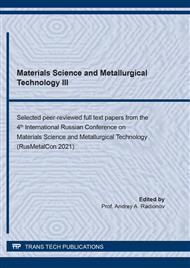[1]
V.R. Ryabov, Application of Bimetallic and Reinforced Steel-Aluminum Joints, Metallurgy, Moscow, (1975).
Google Scholar
[2]
W. Jiang, G. Li, Y. Wu, X. Liu, Z. Fan, Effect of heat treatment on bonding strength of aluminum/steel bimetal produced by a compound casting, J. Mater. Process. Technol. 258 (2018) 239-250.
DOI: 10.1016/j.jmatprotec.2018.04.006
Google Scholar
[3]
G. Liedl, R. Bielak, J. Ivanova, N. Enzinger, G. Figner, J. Bruckner, H. Pasice, M. Pudare, S. Hampelf, Joining of aluminum and steel in car body manufacturing, Phys. Procedia. 12 (2011) 150-156.
DOI: 10.1016/j.phpro.2011.03.019
Google Scholar
[4]
V.I. Kuzmin, V.I. Lysak, S.V. Kuzmin, V.O. Kharlamov, Investigation of the effect of heat treatment on the structure and properties of a steel-aluminum composite with a diffusion barrier, Phys. Met. Mat. Sci. 11 (2015) 1153-1159.
Google Scholar
[5]
L.M. Gurevich, D.V. Pronichev, A.V. Trudov, Yu.P. Trykov, M.D. Trunov, Investigation of the effect of explosion welding and heat treatment modes on the structure and properties of AD1-steelST3 bimetal, Bul. Vol. Tech. Un. 9 (2014) 17-21.
Google Scholar
[6]
R.S. Mikheev, Innovative ways in production antifriction composite coatings based on non-ferrous alloys with increased tribotechnical properties, Blank Prod. Mech. Eng. 5 (2018) 204-210.
Google Scholar
[7]
V.V. Kovalev, R.S. Mikheev, N.V. Kobernik, Features of steel-aluminum joints production by fusion welding methods, Bul. BMSTU, Series Mech. Eng. 3 (2016) 134-151.
Google Scholar
[8]
S. Shankar, D. Apelian, Die soldering: Mechanism of the interface reaction between molten aluminum alloy and tool steel, Metall. Mater. Trans. B. 33 (2002) 465-476.
DOI: 10.1007/s11663-002-0057-7
Google Scholar
[9]
G. Qin, Z. Ao, Y. Chen, C. Zhang, P. Geng, Formability behavior of Al/steel MIG arc brazed-fusion welded joint, J. Mater. Proc. Tech. 273 (2019) 116255.
DOI: 10.1016/j.jmatprotec.2019.116255
Google Scholar
[10]
M. Gatzen, T. Radel, C. Thomy, F. Vollertsen, Wetting behavior of eutectic Al-Si droplets on zinc coated steel substrates, J. Mater. Proc. Tech. 214 (2014) 123-131.
DOI: 10.1016/j.jmatprotec.2013.08.005
Google Scholar
[11]
J.L. Song, S.B. Lin, C.L. Yang, C.L. Fan, Effects of Si additions on intermetallic compound layer of aluminum-steel TIG welding-brazing joint, J. Alloys Compd. 488 (2009) 217-222.
DOI: 10.1016/j.jallcom.2009.08.084
Google Scholar
[12]
H. Dong, W. Hu, Y. Duan, X. Wang, C. Dong, Dissimilar metal joining of aluminum alloy to galvanized steel with Al–Si, Al–Cu, Al–Si–Cu and Zn–Al filler wires, J. Mater. Proc. Tech. 212 (2012) 458-464.
DOI: 10.1016/j.jmatprotec.2011.10.009
Google Scholar
[13]
N. Takata, M. Nishimoto, S. Kobayashi, M. Takeyama, Crystallography of Fe2Al5 phase at the interface between solid Fe and liquid Al, Intermetallics. 67 (2015) 1-11.
DOI: 10.1016/j.intermet.2015.07.011
Google Scholar
[14]
Y. Chang, W. Cheng, C. Wang, Growth and surface morphology of hot-dip Al–Si on 9Cr-1Mo steel, Mater. Charact. 60 (2008) 144-149.
DOI: 10.1016/j.matchar.2008.08.003
Google Scholar
[15]
S. Babu, S.K. Panigrahi, G.D. Janaki Ram, P.V. Venkitakrishnan, R. Suresh Kumar, Cold metal transfer welding of aluminium alloy AA 2219 to austenitic stainless steel AISI 321, J. Mater. Proc. Tech. 266 (2019) 155-164.
DOI: 10.1016/j.jmatprotec.2018.10.034
Google Scholar
[16]
H.T. Zhang, J.C. Feng, P. He, B.B. Zhang, J.M. Chen, L. Wang, The arc characteristics and metal transfer behaviour of cold metal transfer and its use in joining aluminium to zinc-coated steel, Mater. Sci. Eng. A. 499 (2009) 111-113.
DOI: 10.1016/j.msea.2007.11.124
Google Scholar
[17]
H.J. Park, S. Rhee, M.J. Kang, D.C. Kim, Joining of steel to aluminum alloy by AC pulse MIG welding, Mater. Trans. 50 (2009) 2314-2317.
DOI: 10.2320/matertrans.m2009105
Google Scholar
[18]
B. Gundor, E. Kaluc, E. Taban, A. Sik, Mechanical and microstructural properties of robotic Cold Metal Transfer (CMT) welded 5083-H111 and 6082-T651 aluminum alloys, Mat. Design. 54 (2014) 207-211.
DOI: 10.1016/j.matdes.2013.08.018
Google Scholar
[19]
V.V. Okulov, Ed. by V.N. Kudryavtcev, Zinc Plating. Technique and Technology, Globus, Moscow, (2008).
Google Scholar
[20]
W. Han, F. Yin, X. Su, J. Wang, C. Xu, Influence of silicon on growth kinetics of Fe2Al5 during reactive diffusion between solid iron and aluminum, Trans. Mater. Heat Treat. 31 (2010) 28-32.
Google Scholar
[21]
T. Maitra, S.P. Gupta, Intermetallic compound formation in Fe–Al–Si ternary system : Part I, Mater. Charact. 49 (2003) 269-291.
DOI: 10.1016/s1044-5803(03)00006-8
Google Scholar
[22]
T. Maitra, S.P. Gupta, Intermetallic compound formation in Fe–Al–Si ternary system : Part II, Mater. Charact. 49 (2003) 293-311.
DOI: 10.1016/s1044-5803(03)00005-6
Google Scholar
[23]
Y.-Y. Chang, W.-J. Cheng, C.-J. Wang, Growth and surface morphology of hot-dip Al–Si on 9Cr-1Mo steel, Mater. Charact. 60(2) (2009) 144-149.
DOI: 10.1016/j.matchar.2008.08.003
Google Scholar
[24]
J. Wang, P.D. Lee, R.W. Hamilton. M. Li, J. Allison, The kinetics of Fe-rich intermetallic formation in aluminium alloys: In situ observation, Scr. Mater. 6 (2009) 516-519.
DOI: 10.1016/j.scriptamat.2008.11.048
Google Scholar
[25]
M. Akdeniz, O. Mekhrabov, T. Yilmaz, The role of Si addition on the interfacial interaction in Fe-Al diffusion layer, Scr. Metall. Mater. 3 (1994) 1723-1728.
DOI: 10.1016/0956-716x(94)90471-5
Google Scholar
[26]
A. Szczepaniak, J. Fan, A. Kostka, D. Raabe, On the correlation between thermal cycle and formation of intermetallic phases at the interface of laser-welded aluminum-steel overlap joints, Adv. Eng. Mater. 14 (2012) 464-472.
DOI: 10.1002/adem.201200075
Google Scholar
[27]
M.P. Kuzmin, Development of a comparative method for assessing the stability of intermetallic compounds in aluminum and its alloys, XIV Int. Sci. and Tech. Ural School-Seminar. (2013) 238-241.
Google Scholar


